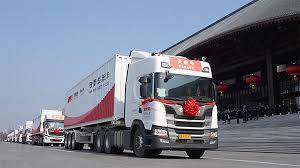2025 China-Central Asia Summit to unlock new opportunities for economic cooperation

As the second China-Central Asia Summit approaches in June 2025, momentum is building for a new era of
economic cooperation between China and Central Asia. Recent years’ developments – from major infrastructure
projects to deepening trade ties – signal a shared commitment to building a more interconnected and prosperous
region.
In December last year, the 5th China-Central Asia Foreign Ministers’ Meeting was held in Chengdu. Foreign
ministers from China, Kazakhstan, Kyrgyzstan, Tajikistan, Turkmenistan and Uzbekistan gathered to reaffirm their
cooperation across a wide range of sectors, with a particular focus on trade, investment and connectivity under the
Belt and Road Initiative (BRI).
After the meeting, the six foreign ministers witnessed the launch of the “Tianfu” cross-border road transport line – a
major logistical route linking China’s southwestern Sichuan Province to Central Asia. Ten trucks loaded with new
energy equipment and local specialty goods departed Chengdu Tianfu New Area, traversing multiple provinces
before heading westward. The route, which cuts delivery time to just 12–18 days, promises to streamline trade,
reduce transportation costs and strengthen regional supply chains.
Since its launch in 2022, the Tianfu cross-border transport service has expanded rapidly, now connecting over 20
cities across five Central Asian countries and delivering more than 40 categories of goods. Foreign ministers at the
launch pledged to further extend the route’s reach and operational efficiency within three years.
In recent years, China and Central Asian countries have deepened their cooperation under the framework of the BRI,
with notable achievements, particularly in trade, investment, infrastructure and energy. As this year’s China-Central
Asia Summit draws near, experts anticipate the event will provide fresh opportunities for deepening economic
cooperation.
A major highlight of the summit will be the China-Kyrgyzstan-Uzbekistan (CKU) Railway. The landmark project,
initiated by the heads of state of the three countries, is set to become a key infrastructure connection between China
and Central Asia. Scheduled to break ground in July 2025, the CKU Railway will shorten transit times, reduce
logistics costs and enhance regional economic integration.
For Central Asia, the railway will be a vital development driver, improving access to international markets for
regional mineral resources and attracting foreign investment.
Wang Jinguo, a professor at the School of Political Science and International Relations at Lanzhou University, said
that the lack of adequate infrastructure has historically been a barrier to trade between Central Asian countries, as
well as between China and the region.
He emphasized that the current mechanism of high-level meetings between China and Central Asia, alongside the
continued advancement of the BRI, not only improves trade connectivity and reduces costs but also plays a crucial
role in promoting economic growth and regional integration across Central Asia.
To better support and coordinate China-Central Asia cooperation, China has introduced several multilateral
platforms since the first China-Central Asia Summit in May 2023, including meetings for economic, trade and
investment ministers. The launch of the China-Central Asia Secretariat in March 2024 further institutionalized this
cooperation, enhancing the implementation of future agreements.
The growing economic ties between China and Central Asia are reflected in the numbers. Bilateral trade surged from
just $460 million at the start of diplomatic relations to nearly $95 billion in 2024. The growth has accelerated in
recent years: trade exceeded $50 billion in 2021, climbed to $70.2 billion in 2022 and reached $89.4 billion in
- In 2025, trade continues to show strong growth momentum.
Amid global trade uncertainties and the ongoing effects of the Russia-Ukraine conflict, China advocates for a closer
China-Central Asia community with a shared future. This vision, grounded in multilateralism and the principles of
open trade, was reaffirmed at the Sixth China-Central Asia Foreign Ministers’ Meeting in April this year, where
member states issued a joint communiqué to deepen BRI cooperation and promote regional stability.
With the upcoming summit in Kazakhstan set to unveil new initiatives and formalize key projects, the China-Central
Asia partnership is entering a phase of strategic depth, unlocking fresh opportunities for economic cooperation and
regional integration.





